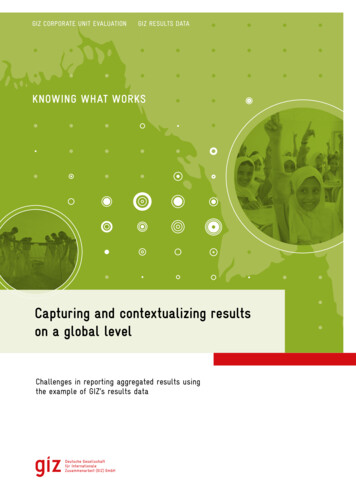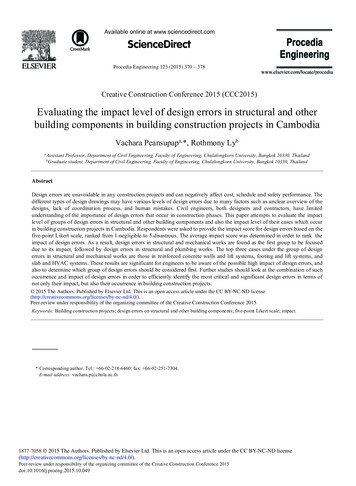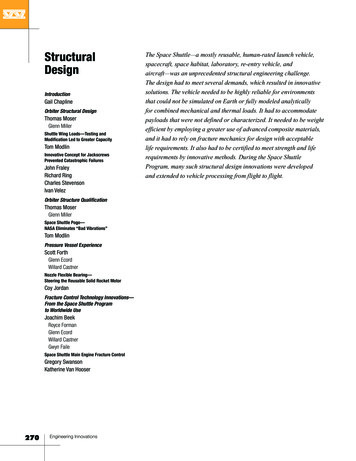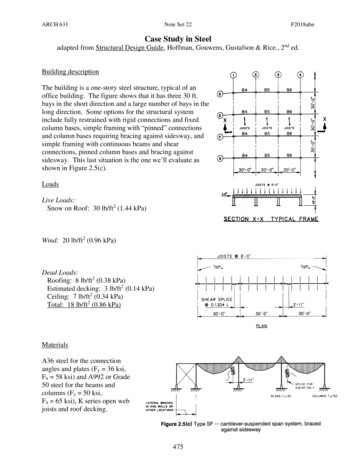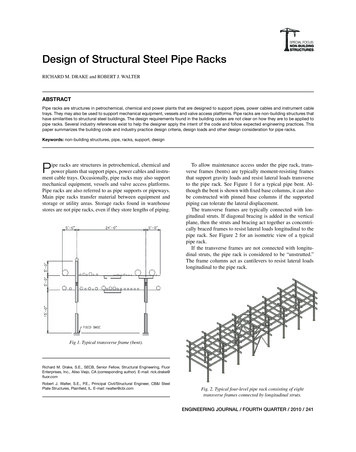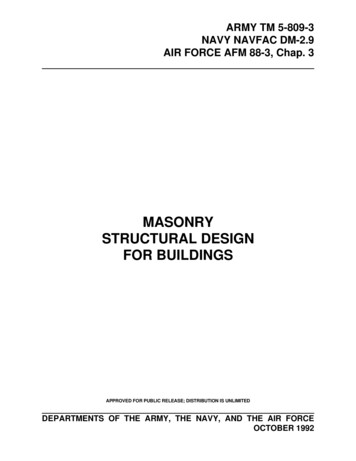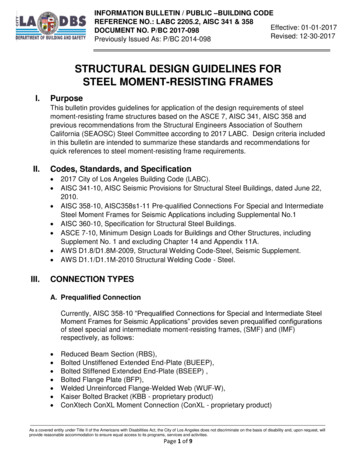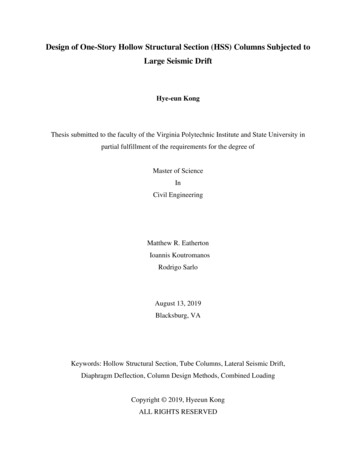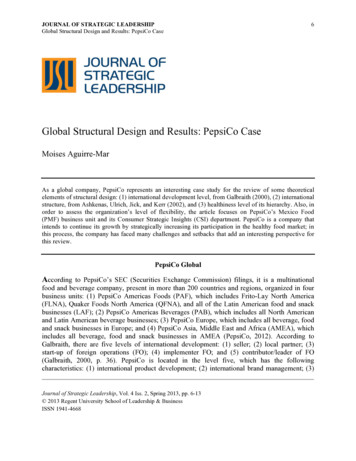
Transcription
JOURNAL OF STRATEGIC LEADERSHIPGlobal Structural Design and Results: PepsiCo Case6Global Structural Design and Results: PepsiCo CaseMoises Aguirre-MarAs a global company, PepsiCo represents an interesting case study for the review of some theoreticalelements of structural design: (1) international development level, from Galbraith (2000), (2) internationalstructure, from Ashkenas, Ulrich, Jick, and Kerr (2002), and (3) healthiness level of its hierarchy. Also, inorder to assess the organization’s level of flexibility, the article focuses on PepsiCo’s Mexico Food(PMF) business unit and its Consumer Strategic Insights (CSI) department. PepsiCo is a company thatintends to continue its growth by strategically increasing its participation in the healthy food market; inthis process, the company has faced many challenges and setbacks that add an interesting perspective forthis review.PepsiCo GlobalAccording to PepsiCo’s SEC (Securities Exchange Commission) filings, it is a multinationalfood and beverage company, present in more than 200 countries and regions, organized in fourbusiness units: (1) PepsiCo Americas Foods (PAF), which includes Frito-Lay North America(FLNA), Quaker Foods North America (QFNA), and all of the Latin American food and snackbusinesses (LAF); (2) PepsiCo Americas Beverages (PAB), which includes all North Americanand Latin American beverage businesses; (3) PepsiCo Europe, which includes all beverage, foodand snack businesses in Europe; and (4) PepsiCo Asia, Middle East and Africa (AMEA), whichincludes all beverage, food and snack businesses in AMEA (PepsiCo, 2012). According toGalbraith, there are five levels of international development: (1) seller; (2) local partner; (3)start-up of foreign operations (FO); (4) implementer FO; and (5) contributor/leader of FO(Galbraith, 2000, p. 36). PepsiCo is located in the level five, which has the followingcharacteristics: (1) international product development; (2) international brand management; (3)Journal of Strategic Leadership, Vol. 4 Iss. 2, Spring 2013, pp. 6-13 2013 Regent University School of Leadership & BusinessISSN 1941-4668
JOURNAL OF STRATEGIC LEADERSHIPGlobal Structural Design and Results: PepsiCo Case7international partnering; (4) transfer and modification resource advantage from any country; (5)cross-unit integration; and (6) management of distributed headquarters (p. 46-47). Galbraithcontends: “The organizational challenge to a multinational company has always been theintegration of activities that take place in different countries” (p. 3).PepsiCo, as with most organizations, has adopted a geographical division. Galbraith (2000) saidthat this structural strategy is implemented due to the following reasons: (1) the customary startup activities of an expansion—sales, distribution, service, and local marketing—are bestorganized on a geographical basis; (2) to provide emphasis and focus; (3) to signal strategicpositions and possible candidates for upper levels; and (4) allocate and conserve scarce resources(p. 71-72).PepsiCo has almost 300 thousand employees around the world (PepsiCo, 2012b). According toits webpage, their guiding principles are: “We must always strive to: (1) care for our customers,consumers and the world we live in; (2) sell only products we can be proud of; (3) speak withtruth and candor; (3) balance short term and long term; (4) win with diversity and inclusion; (5)respect others and succeed together” (PepsiCo, 2012a). The application of these principlesincludes all the stakeholders of the company, which is, by the way, a complex task to promoteand evaluate. In the line of brand value, Pepsi is ranked in the 22nd place on the Interbrand list.This list evaluates the top global brands’ value; it is interesting that Coca-Cola, PepsiCo’s maincompetitor, has kept its position as the world’s most valuable brand for the past 12 years(Wharton, 2003, p. 3).Indra Nooyi has been PepsiCo’s CEO since 2006 (PepsiCo, 2012c). Her main strategic goal is totransform the company “from a purveyor of sugar-laden bubbly beverages and salty snacks, intoone that has healthier and more wholesome offerings” (Wharton, 2012, p. 1). However, in theimplementation of this strategic process there are some financial setbacks that the company isfacing nowadays. “Investors are impatient. Some accuse Nooyi of focusing too intensely on herstrategy while overlooking PepsiCo’s North American soft drink business,” which is today’shighest source of revenues (p. 1). Some analysts stated that Nooyi should not abandon her plans;but, rather, she needs to develop a strategy that better balances the short term with the long term.According to Yoram (Jerry) Wind, Wharton’s director of the SEI Center for Advanced Studies inManagement, “Companies can be socially responsible, provide more nutritional and healthierproducts and still be profitable, but it requires careful management of board and Wall Streetexpectations” (p. 4).PepsiCo’s Executives’ Income and HierarchyHeroic leadership style and the statements of the top executives. Stauffer (1998) saidthat the heroic leadership style is like “CEO-as Patton genre of leadership.” He also mentionedthat it is common for organizations to fall into what he called “the self-reinforcing heroic circle”which has the following elements: (1) the leader feels responsible for the group, directions,Journal of Strategic Leadership, Vol. 4 Iss. 2, Spring 2013, pp. 6-13 2013 Regent University School of Leadership & BusinessISSN 1941-4668
JOURNAL OF STRATEGIC LEADERSHIPGlobal Structural Design and Results: PepsiCo Case8structure, and management; (2) the leader takes the initiative, controls the agenda, makes theimportant decisions; (3) subordinates agree that the leader is responsible for the overall group;(4) subordinates focus on their own subunits; (5) subordinates contribute, but within limitedboundaries, provide weak pushback against the leader’s ideas; (6) leaders sense lack ofownership. Then the circle returns to first element and so on. This is a cycle that has the powerto self-reinforce the paradigm with its implied virtues and defects. In the 10K SEC filing report,the board of directors made the following statement: “PepsiCo’s Board of Directors isresponsible for overseeing the company’s risk assessment and mitigation, receives updates onkey risks throughout the year” (PepsiCo, 2012b). This statement emphasizes the paradigm ofheroic leaders and reinforces the hierarchy paradigm, regardless of if it is a healthy one or not(Ashkenas et al., 2002, p. 42). Ashkenas et al. (2002) said that, in vertical hierarchies, roles areclearly defined and more authority resides higher up in the organization than in lowerlevels when rank has its privilege, it is a clear symbol of vertical boundaries (p. 10). They alsocontend that healthy hierarchies are those that meet the success requirements of organizations forthe twenty-first century: speed, flexibility, innovation and integration (p. 42).Healthy vs. unhealthy hierarchy. According to the proxy report, PepsiCo’s CEO earnsthe highest salary in the company and has access to the greatest compensation package (stockoptions), followed in amount and access by the immediate inferior organizational ranks and soon (PepsiCo, 2012a, p. 33–38). It seems that this very fact accentuates the hierarchical-heroicparadigm in the company. Traditional hierarchies reward based on positions and levels, and notin superior performance (Ashkenas et al., 2002, p. 50). Despite the fact that hierarchies arerequired, as Keidel (1995) stated: “No society, organization, or family can ever function withoutsome measure of hierarchical control, role specialization, and sense of limit,” (p. 22), the realquestion is whether these hierarchies are healthy or unhealthy. Ashkenas et al. (2002) said “thereare five warning signals of a dysfunctional hierarchy: (1) slow response time: when anorganization takes too long to make decisions, respond to customer requests, or react to changesin market conditions; (2) rigidity toward change: when an organization insists “we have alwaysdone this way,” or spend more effort finding ways not to change than on changing; (3)underground activity: when creativity and innovation are driven underground; (4) internalfrustration: employees and managers feel dissatisfied with the organization, the way it works andthe way it treats them; (5) customer alienation: customers feel frustrated and angry because theyfeel they are not listened to” (p. 44). Wind pointed out some of the mistakes that have been madeunder Nooyi’s leadership: “They allowed the firm’s core brand to languish PepsiCo elected notto advertise during the Super Bowl telecast, one of the most-watched TV events of the year;instead they spent 20 million dollars in a project named the Pepsi refresh project to support localcommunities; however, according to Advertising Age this project has not had a major influenceon the brand’s bottom line. During China’s Olympic Games, Coca-Cola invested heavily inmarketing; now they have 17 percent of the market. PepsiCo did not market aggressively in thesame period; as a result, PepsiCo’s market share fell to 6 percent. Coca-Cola invested 10 milliondollars in the American Idol TV show, after PepsiCo passed on the opportunity to sponsor it;Journal of Strategic Leadership, Vol. 4 Iss. 2, Spring 2013, pp. 6-13 2013 Regent University School of Leadership & BusinessISSN 1941-4668
JOURNAL OF STRATEGIC LEADERSHIPGlobal Structural Design and Results: PepsiCo Case9later on, they sponsored the X Factor, a competing TV show to American Idol, at the cost of 60million dollars” (Wharton, 2012, p. 3). PepsiCo seems to have been reactive, or at least slow tomove in their marketing strategies. The relationship between unhealthy hierarchy and the rewardsystem based on positions are evident. Ashkenas et al. (2002) contend that, in order to createhealthy hierarchies, the basis of the reward system must be changed from position toperformance with two main objectives: (1) to recognize past performance; and (2) to stimulatecompetent (or different) performance in the future people who make good contributions andadd to their skills are rewarded (2002, p. 51).When reviewing these statements in the internal documents of the company, and the observationsmade by other market analysts, the conclusion is that PepsiCo is a traditional semi-rigid(unhealthy) hierarchy trying to move ahead into a more healthy structure in order to becomemore competitive in the market. The task is possible, if Wall Street gives them enough time toaccomplish it (Wharton, 2012, p. 4). PepsiCo’s third guiding principle is attaining balance withthe long and short term, which may be the Achilles’ heel of Nooyi and other PepsiCo topexecutives (p. 4). The chances to be successful in their plans would increase if the reward systemwould change from being a reward system based on position to one based on performance.PepsiCo Foods Mexico and the CSI departmentPepsiCo Foods Mexico (PFM). In order to review PepsiCo’s organizational structure intheir Mexico business unit, an interview with Jorge Rubio, national director of CSI (ConsumerStrategic Insights) for PFM, was conducted. This unit has two main divisions: beverage andfoods. Due to the fact that Rubio’s office is situated inside the foods division, this section of thearticle focuses on PFM and the CSI department.According to the SEC 10K report, Latin American foods (LAF) represent 7.2 billion inrevenues (PepsiCo, 2012b, p. 4); Rubio said that PFM contributes with 5 billion; representing 7percent of PepsiCo’s total sales (J. Rubio, personal communication, October 25, 2012). There arethree business units within PFM division: (1) Gamesa (cookies and crackers) with headquartersin Monterrey; (2) Sabritas (similar to Lay’s chips), with headquarters in Mexico City; and (3)Quaker (cereals and healthy food) with headquarters in Guadalajara. The three business units arein a merger process since March of 2012; at the end of this process, there will be one businessunit with three different approaches according to the market category in which they arecompeting (J. Rubio, personal communication, October 25, 2012). PFM competes with a leadingposition in cookies and crackers (Gamesa) and in chips (Sabritas); and also has a small marketshare in candy categories (Sonrics). In all three categories, the main competitor is Bimbo, whichis the largest baking products manufacturer in the world (J. Rubio, personal communication,October 25, 2012).The above-mentioned categories in Mexico have an estimated market value of 15 billion, andPFM has a market share of 5 billion or thirty-three percent of the market (J. Rubio, personalJournal of Strategic Leadership, Vol. 4 Iss. 2, Spring 2013, pp. 6-13 2013 Regent University School of Leadership & BusinessISSN 1941-4668
JOURNAL OF STRATEGIC LEADERSHIPGlobal Structural Design and Results: PepsiCo Case10communication, October 25, 2012). Rubio pointed out that the core of this strategic market battleis distribution. Eighty percent of sales are made through direct sales to changarros (family-ownedsmall stores). Coca-Cola is the leader in distribution with a scope of 1.2 million of changarros,whereas Gamesa can only reach 700 thousand changarros (J. Rubio, personal communication,October 25, 2012). This means that every day, thousands of vehicles transport these companies’products nationwide. There is a popular saying among the Mexican people: they say that even inthe most remote villages of the sierra, you will find a changarro with Coca-Cola, Bimbo bread,Gamesa cookies, and Sabritas chips on sale. For this to happen, every company needs to have ahighly efficient logistics system to deal with transportation, information technologies, storage,label and packaging requirements, to keep the products fresh and the like (J. Rubio, personalcommunication, October 25, 2012). Nadler and Tushman said: “No strategy, no
that this structural strategy is implemented due to the following reasons: (1) the customary start-up activities of an expansion—sales, distribution, service, and local marketing—are best organized on a geographical basis; (2) to provide emphasis and focus; (3) to signal strategicFile Size: 258KBPage Count: 8

